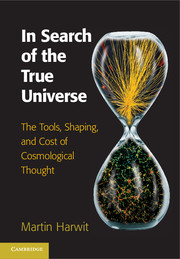Book contents
- Frontmatter
- Contents
- Preface
- Notes on Usage
- 1 The Nineteenth Century's Last Five Years
- Part I The Import of Theoretical Tools
- 2 An Overview
- 3 Conclusions Based on Principles
- 4 Conclusions Based on a Premise
- 5 Conclusions Based on Calculations
- 6 Ask the Right Questions, Accept Limited Answers
- Part II A National Plan Shaping the Universe We Perceive
- Part III The Cost of Discerning the True Universe
- Epilogue
- Appendix: Symbols, Glossary, Units and Their Ranges
- Index
- References
4 - Conclusions Based on a Premise
Published online by Cambridge University Press: 05 December 2013
- Frontmatter
- Contents
- Preface
- Notes on Usage
- 1 The Nineteenth Century's Last Five Years
- Part I The Import of Theoretical Tools
- 2 An Overview
- 3 Conclusions Based on Principles
- 4 Conclusions Based on a Premise
- 5 Conclusions Based on Calculations
- 6 Ask the Right Questions, Accept Limited Answers
- Part II A National Plan Shaping the Universe We Perceive
- Part III The Cost of Discerning the True Universe
- Epilogue
- Appendix: Symbols, Glossary, Units and Their Ranges
- Index
- References
Summary
Scientific work is generally based on a premise, a hunch that certain assumptions can safely lead to useful advances. As new observations, experimental evidence, or calculations accumulate, the premise may then lead to a coherent view that includes predictions concerning future observations. When those observations only partially vindicate the evolving world view, corrections or modifications may be necessary, and so an increasingly complex world view emerges, whose intricate details need to be understood in terms of an overarching theory. Where the theory appears enigmatic, new physical processes may be hypothesized to make the theory more understandable. A search is set in motion to identify those processes, and so the work continues.
Two Legacies from the Nineteenth Century
The Chemical Elements in the Sun
In 1859, the Heidelberg physicist Gustav Robert Kirchhoff and his colleague, the chemist Robert Wilhelm Bunsen, discovered that a minute trace of strontium chloride injected into a flame gave rise to a spectrum that clearly identified the presence of the element strontium. Sodium was also readily identified by a spectrum exhibiting two bright, closely spaced features, whose wavelengths corresponded precisely to two dark features in the spectrum of the Sun.
Later that year, Kirchhoff passed a beam of sunlight through a flame containing vaporized sodium. To his surprise, instead of filling the dark solar features with compensating light emitted by the flame, the solar features actually darkened. The faint light emanating from the Sun appeared to be absorbed by the flame.
- Type
- Chapter
- Information
- In Search of the True UniverseThe Tools, Shaping, and Cost of Cosmological Thought, pp. 55 - 75Publisher: Cambridge University PressPrint publication year: 2013



